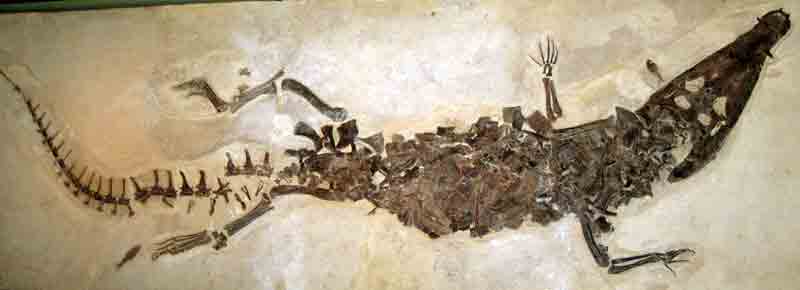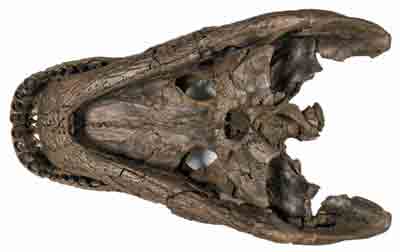Lot of 5 Mixed Fossil Teeth Prehistoric Crocodiles mm 2-4 Armored Loricates Extinct Reptiles Mesozoic Cretaceous Collecting Paleontology Museum.
Species to which they belong: Brachychampsa montana and Borealosuchus sternbergi.
Nice collectible fossil finds in excellent condition, museum quality specimens with excellent front and back surface detail and perfectly preserved enamel.
No restoration at all, as in photos.
For sale on our site also single teeth of the same species.
Borealosuchus, whose name means "northern crocodile", is an extinct genus of crocodile, lived between the Upper Cretaceous and the Eocene (70 - 50 million years ago). Its genus survived on long after the extinction that ended the age of dinosaurs. His remains have been found in numerous fossiliferous locations in North America.
It was a medium-sized crocodile that reached up to 2.8 meters in length with a skull of 36 centimeters. This animal was quite similar to today's crocodile, but some characteristics, particularly of the skull, indicate that Borealosuchus looked halfway between an alligator and a real crocodile. The snout was relatively long and narrow, but nevertheless it was rather robust.
The genus Borealosuchus was established in 1997, including six currently recognized species. In order of denomination, are B. sternbergii, B. acutidentatus, B. wilsoni, B. formidabilis, B. griffithi and B. threeensis. Four of these species (B. sternbergi, B. acutidentatus, B. wilsoni and B. formidabilis) were originally called Leidosuchus species. A sixth species of Borealosuchus, B. threeensis, was named in 2012. Fossils of this species were found in the Inversand Company Marl Pit of Gloucester County, New Jersey
The species is Borealosuchus sternbergi, found in layers of the Upper Cretaceous (Maastrichtian) in Colorado, Montana, North Dakota, South Dakota and Wyoming. B. acutidentatus, however, lived in the Paleocene in Saskatchewan, while B. griffithi comes from the Paleocene of Alberta and B. wilsoni from the Eocene of Wyoming. The best-known species is B. formidabilis, whose numerous remains were found in North Dakota in layers of the Paleocene, at the Wannagan Creek site. Borealosuchus is considered a primitive representative of the Crocodylia, ancestral to both true crocodiles and alligators, and perhaps even more basal than forms like Boverisuchus. The species Borealosuchus formidabilis lived in a warm and humid environment, consisting of tropical lagoons and marshes. The weather had to be similar to that of current Florida. Borealosuchus was to be an excellent hunter of fish and other aquatic vertebrates.
According to Brochu et al. (2012) most of the phylogenetic analyzes have recovered Borealosuchus as a crocodile more closely related to the clade Brevirostres than to Gavialoidea, some have recovered as more closely related to gavialoids or as a basal Eusuchian not belonging to the Crocodylia. According to Brochu's own analysis and co-authors, all three hypotheses are equally parsimonious.
Brachychampsa, is an extinct genus of freshwater carnivore alligatorous reptile, one of the first alligators known by science. It lived between Upper Cretaceous and the Lower Paleocene, about 83.5-63.3 million years ago (Campanian-Danian), in New Mexico, Colorado, Wyoming, Montana, North and South Dakota, New Jersey and Saskatchewan.
The first fossil specimen was discovered in Montana at Hell Creek, a rock formation dating back to the end of the Cretaceous period.
Another specimen was also found in the Darbasa Formation of Kazakhstan, although it was not possible to classify its species.

Brachychampsa is distinguished by a fourth enlarged premolar in the upper jaw. He had short teeth and a large mouth with more power than the current alligators. These characteristics suggest that this reptile feeds on turtles, which are very common in the Hell Creek fossil fauna.
Although part of the Alligatoroidea superfamily, the phylogenetic analysis of Brachychampsa underwent several revisions. Originally the animal had been placed in the Alligatoridae family, and was then perfected in the subfamily of the Alligatorinae in 1964, only to be placed outside both Alligatorinae and Alligatoridae (but still within Alligatoroidea), in 1994.
The first ancestor of alligators dates back to 245 million years ago. Only about 80 million years ago, during the Cretaceous period, the first crocodiles appeared. This group includes both alligatoros, such as Brachychampsa, and its closest relatives such as crocodiles and caimans. Many of these ancient animals survived the great extinction of the K-T period. Modern alligators are still very similar and related to their ancient ancestors 80 million years ago.
The typical species of Brachychampsa, B. montana, was discovered in the Hell Creek Formation in Montana, described by Charles W. Gilmore in an article, in 1911. In that same document, Gilmore renamed Bottosaurus perrugosus as a new species of Brachychampsa, calling it B. perrugosus. The holotypical specimen of B. perrugosus disappeared as well as the paper that described it, but was subsequently rediscovered and shortly afterwards designated as nomen dubium due to the lack of diagnostic features that distinguished it from other alligatorids. Another species, from the Menefee Formation, of the San Juan Basin, B. sealeyi, was discovered in 1996, although it is thought that it may be a synonym of B. montana, specifically a young specimen of the latter species. However, other studies argue that some of the variations seen between the two species, such as the maxillary orientation of the tooth rows, can not be ontogenetic, making B. sealeyi a valid taxon.


